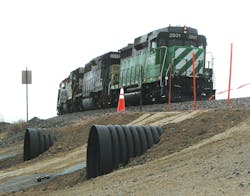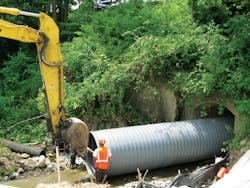About the author: Daniel Currence, P.E., is director of engineering, Corrugated Plastic Pipe Div., for the Plastics Pipe Institute Inc. Currence can be reached at [email protected] or 469-499-1049.
Polyethylene (PE), a thermoplastic resin, was first produced in 1933. During the next 20 years, petrochemical industry chemists advanced the manufacturing process to diminish costs while yielding better grades. In the early 1950s, chemists at the Phillips Petroleum Co. developed an economical process and delivered a new grade of polyethylene called high-density polyethylene (HDPE). At that time, it became possible to create various grades of PE, and soon the resin was being used in a variety of products and applications.
The first use of HDPE was for baby bottles. Using it instead of glass was the start of HDPE replacing traditional materials due to its improved physical properties. It does not break like glass, is less expensive to produce, and is safe. Today, HDPE has replaced glass for bottles and metal for pails, drums, and gas tanks, and it is used for many other applications, including packaging and pipeline components and systems. According to a Plastics News December 2016 report, sales of HDPE in North America and Mexico have reached nearly 16 billion lb, with more capacity coming on-stream this year.
HDPE History
For pipe, the grade of HDPE used now is different from early-generation materials, and even quite different from other HDPE materials used in today’s consumer applications. Pipe-grade HDPE is a highly engineered compound designed for long-term service in critical applications. It is put through a series of rigorous testing procedures before it is available for manufacturing.
Solid-wall HDPE pipe began replacing metal pipe in oil- and gas-gathering systems in the late 1950s. In the early 1960s, gas utilities started replacing failing iron pipe with PE pipe, and because of its successful performance history, 95% of all new gas distribution systems installed today use PE pipe. Soon, corrugated HDPE pipe started to replace clay pipe in agricultural drainage systems. In the late 1980s, large-diameter corrugated HDPE pipe began to replace metal and concrete in storm water culverts. The material has continued to evolve into what is now its third and fourth generation of development, each with improved performance capabilities.
Thermoplastic piping systems are sustainable and environmentally responsible for pipe selection. They are energy efficient during manufacturing and provide peak protection from contamination during service. They also require significantly less energy to fabricate, transport and install than metal or concrete alternatives. With resistance to corrosion and abrasion, plastic piping systems also supply long service life, provide excellent joint performance and offer leak-free protection, making it a good value.
For centuries, farmers knew that proper field drainage, along with irrigation, was a key part of increasing crop yields, so they used clay tiles. Studies show that soybean yields increased 43% and corn 30% when fields are “tiled.” With the advent of HDPE resin and the ability to make corrugated pipe, the agriculture market became the starting point of more pipe development. In less than one generation, corrugated HDPE pipe displaced a product that had been used for hundreds of years. Larger diameters soon followed to provide for new applications, especially in department of transportation and other public storm drainage projects.
Polymer for Performance
A pipe-grade HDPE resin is a compound that consists of a PE copolymer, also known as the resin, to which colorants, stabilizers, antioxidants and other ingredients have been added to enhance the properties of the material. The formulation yields HDPE pipe, which is tough, durable and strong.
HDPE pipe materials are almost exclusively classified as thermoplastics because they soften and melt when sufficiently heated and then harden when cooled. This process also can be reversed, allowing the resin to be recycled into other applications at the end of the pipe’s service life.
As an extensively tested material, HDPE pipe provides performance that has been widely documented and is persistently validated through ongoing laboratory research and decades of in-field service. Design engineers for other utilities continue to discover benefits and identify new uses for HDPE products. For example, because PE produced for pipe is an engineered resin, it provides the pipe with a favorable strength-to-weight ratio. Some of the reasons for HDPE pipe’s wide and varied applications include the material’s ease of handling and freedom from attack by soils, chemicals, ambient water and moisture, and the fact that it will not corrode or rust. Because HDPE is a non-conductor of electricity, it is immune to the electrochemical-based corrosion process induced by electrolytes such as salts, acids and bases.
HDPE pipe is not vulnerable to biological attack or tuberculation, is resistant to bio-clogging, and maintains high, consistent flow capacities throughout the service life of each system. This translates into less wear and tear, providing significant savings to an operating utility.
In addition, miles of corrugated HDPE pipe can quickly be installed because diameters smaller than 6 in. can be purchased in large coiled reels of thousands of feet of pipe, especially to tile farm fields.
Codes for Compliance
Beyond the standards for the material formulated to make corrugated HDPE pipe, it is important to note that the pipe is manufactured, certified and installed in accordance with numerous industry standards from organizations such as AASHTO, ASTM, CSA Group and the American Railway Engineering and Maintenance-of-Way Assn. (AREMA). Plus, it is approved for use by the Federal Aviation Administration, departments of transportation, and other federal and local agencies. These national standards regularly are reviewed by the variety of industry organizations and their memberships. Efforts continually are made to keep the standards current, enhance and strengthen test criteria, and advance for raw material and post-manufactured pipe. The testing protocol can be extensive and extreme.
For example, one test for the railroad industry was conducted by the Transportation Technology Center Inc. at the Facility for Accelerated Service Testing in Pueblo, Colo., where it operates a test bed for railroad track. The methodology for this test included repeatedly running a train consisting of four locomotives and 80 rail cars weighing 315,000 lb over 48-in. corrugated HDPE pipe with 4 ft of cover between the top of the pipe and the bottom of the rail. In addition to the performance evaluation, the long-term impact of heavy, static loads on the pipe was assessed by parking the cars, with one set of wheels on the track directly over the same pipe for six weeks. Following this test and upon review of accumulated data, the approved use of HDPE pipe was added to the AREMA manual.
By submitting products and passing independent tests, manufacturers assure customers that their products meet the requirements of the standards, including the requirements on physical properties, joining and installation methods.
Coupling Confidence
Initially, the only joining mechanisms for corrugated HDPE pipe were banding together couplers that secure two plain-end pipes to form a soil-tight connection. This type of coupler still is commonly used in agriculture applications, when making fitting connections in the field, and in other applications. Higher-integrity joints between pipe sections were developed during the 1980s with bell-bell coupling systems, typically used more for sanitary sewer than storm water drainage systems. Then the integral bell and spigot type coupling was perfected. This remains the most commonly used joining method for dual-wall corrugated HDPE pipe. The next generation of couplers has an extended inner sleeve that provides more engagement for the pipe sections. This can help in situations where watertight integrity is needed and where field verification tests are performed on the joints.
While today, corrugated thermoplastic pipe is available in sizes up to a 60-in. diameter, there are projects currently underway by machinery manufacturers to make the pipe in 72 and 84-in. diameters.
One of the latest developments in the U.S. is the availability of polypropylene pipe in diameters up to 60 in. with a structural core that provides higher stiffness and beam strength. The engineered grade of polypropylene is resistant to chemicals—even sulfuric acid found in sanitary sewer lines.
The practicality of HDPE and polypropylene pipe systems has been recognized. These materials are now being used in greater volumes for sewer and drainage projects. Resin availability is increasing, pipe manufacturers are adding production capacity, and new developments in both raw materials and pipe system designs are illustrating that thermoplastic pipe applications are smart and reliable choices. The industry will continue engaging in advancements—just as the industry has done for more than a half a century. As a thoroughly vetted and progressive solution, thermoplastic pipe systems will deliver services and meet the world’s demands for generations to come.
In the late 1980s, large-diameter corrugated HDPE pipe began to replace metal and concrete in storm water culverts.

